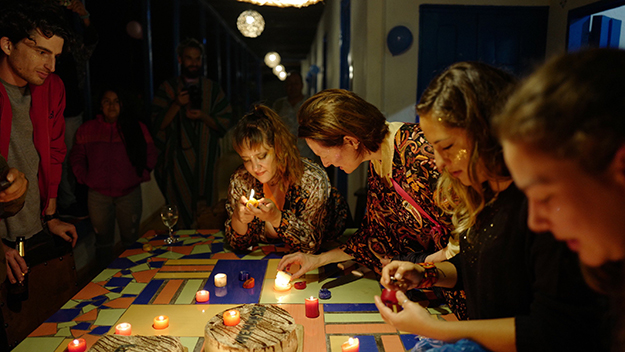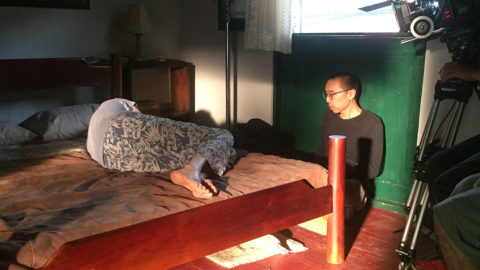Set Diary: Apichatpong Weerasethakul’s Memoria, pt. 6

Photo from Apichatpong Weerasethakul’s Twitter
I was invited to follow the shoot of Apichatpong Weerasethakul’s Memoria in order to collect material for an upcoming book to be published by Fireflies Press. This included writing a daily diary of the production, from which the following passages are excerpted exclusively in Film Comment, in serialized form with a new entry every afternoon for the next week. This is the final entry. Read the entire series here.
Day 35—Friday, 4 October 2019
Ironically, given the number of delays caused by rain, now it’s sunshine that’s keeping the shoot hostage. The only item left on today’s schedule is the climax’s centerpiece, a wide shot that will extend across a full roll of film. A manifest tension reigns amongst the crew as we wait for clouds. The scene is of such dramatic complexity, even Tilda seems unsettled by the demands of her performance. An hour later, the sky is still clear but we’re nearing sunset and Sayombhu says there will be a 15-minute shooting window as the sun dips behind the mountains. Everything gets set up, the room is cleared of all but the essential crew, the door is closed, and the rest of us crowd around the monitor across the wall. The instant the light is right, the camera starts rolling.
In the film, the characters will be navigating an intricately designed soundscape, reacting to a variety of auditory stimuli, but on set there is no substitute soundtrack to guide the actors. Instead, Apichatpong sits as close to them as possible and, speaking in a soft voice, describes sound cues along with the emotions and mental images they should elicit. His improvised narration becomes increasingly abstract as the scene nears its high point and it’s at once surreal and hypnotic to watch the actors give it form, interpreting his words in fluid, almost Tai chi-like motions. When Sayombhu calls, “Roll out!”, it provokes a violent jolt, as if a bubble containing the set suddenly burst.
Reviewing the take on the video assist, Apichatpong is ecstatic: “It’s really, really beautiful. I don’t think we need the close-up, it’s not going to work. The other insert also won’t work. This works!” We all go out on the porch so that Raúl [Locatelli, the sound recorder] can record a wild track inside the house. Waiting for him to finish, everyone stands mute and motionless, looking out at the view as the twilight grows darker, enveloped by a palpable air of relief. Euphoria, even.
Day 42—Saturday, 12 October 2019
Several scenes in the film will look like they were shot in wild nature, when actually, had the camera panned a few degrees, it would have revealed a building or at the very least a paved road. It’s only today, the final day of the shoot, that we’re deep in a bona fide jungle. We’ve come to a natural reserve a two-hour drive from Pijao, hoping to find howler monkeys. As only twelve people are allowed in at a time, everyone is loaded with gear. It feels screamingly injudicious to be carrying so much unwieldy and expensive material across muddy ground, up and down steep inclines, and through vegetation so thick, you can barely see more than a few feet ahead; at one point, we cross a rickety hanging bridge the width of a foot that can only carry one person at a time. That Omar [Moreno, the 1st AC] never drops the 50-pound camera, held on his shoulder with one hand, is borderline heroic. After more than three hours trying to track down monkeys, their howls frequently rumbling in the distance, we have to make our way back. It’s not a tragedy, stock footage will be used instead, but it’s difficult not to feel a tinge of disappointment when Apichatpong calls the film wrapped empty-handed.
As we re-emerge from the jungle, a reserve employee walks over and points to a nearby tree: three monkeys, up in the tall branches, calmly munching on leaves. Sayombhu and his team set up the camera and everyone hides behind plants, waiting for the monkeys to come out of the thick foliage. After a while, the reserve employee attempts to lure them out by mimicking their call. Nothing. He then sends his dog to the bottom of their tree, hoping to alarm them. Equally fruitless. At a loss, we decide to all simultaneously scream as loudly as possible: “One… two… three… AHHHHH!!!” Not only futile, also embarrassing. Santiago [Porras, the 1st AD] then radios Juancho [Correal Ramirez, the location and unit manager] and asks him to fly his drone over, directing him until the drone is hovering a few feet above to monkeys’ heads, making an infernal racket. (Why it’s considered a disturbance for more than twelve people to enter the reserve, whereas this literal harassment is gladly sanctioned, I cannot fathom.) This does get their attention, but after a quick glance upwards, they simply go back to eating. At long last, we concede defeat. Just then, as we’re getting up to leave, one of the monkeys comes fully into view. Sayombhu leaps to his viewfinder and films the monkey as it leisurely climbs up a branch, swings over to another and, after loitering a while, disappears back into the greenery. As a note to end on, this feels almost mystical.
The sun is setting by the time we’re on the road. We drive the whole way in silence, with most of the crew asleep for the duration of the journey. It’s our last night in Pijao. Many of us are getting picked up for the airport at 3am, the rest will leave during the day. While some may return, perhaps out of nostalgia, it’s likely that most won’t. It dawns on me that even if I never come back, I will always have the chance to revisit by watching the film. As Jacques Rivette said, every film is a documentary of its own making, but few validate that aphorism to the extent of this one. Virtually every street in Pijao, every house we lived in, every café, every bar, every shop is captured in a shot, or hiding just beyond the frame. Hundreds of locals appear as extras, all faces that have grown familiar over the last month. The mountain panorama is photographed from innumerable vantages. The plaza’s day and night-time ambience are recorded in several scenes. The hospital, the mayor’s office, the church, the bridge, the stream, the playground, the colorful staircase… all of it will be in the film. Memoria, indeed.
Read the series here.







